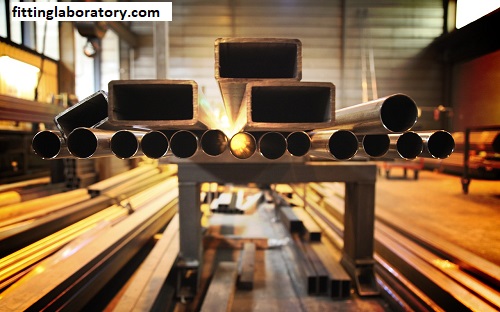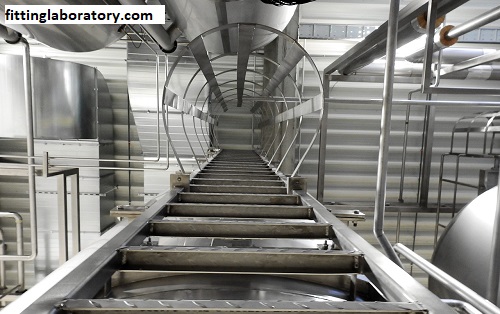Inside-Out Primer Stainless Steel Pipe Fittings:
Stainless Steel Pipe Fittings:
Stainless steel pipe fittings are themselves within the piping systems, but they facilitate the flow of fluids in many industries. From strength to flexibility and resistance to corrosion, stainless steel becomes very handy for such applications as plumbing, chemical processing, HVAC, and food and beverage manufacturing.

This piece will cover the types, advantages, and uses of stainless steel pipe fittings along with a list of frequently asked questions that explain such an important tool in most essential aspects that people clearly understand.
What are Stainless Steel Pipe Fittings?
Stainless Steel Pipe Fittings:
- Stainless steel pipe fittings are those fittings that connect, join, or change the direction of pipelines in a pipeline system. The stainless steel fittings are an alloy made up of iron, and chromium usually between 10-20% but sometimes other elements may be there such as nickel, molybdenum as well as manganese. The strength of stainless steel comes with excellent resistance to corrosion and high tensile strength supplemented with outstanding characteristics concerning extreme temperature-resistant properties. Stainless steel is extremely popular when choosing pipe fittings.
- Pipe fittings differ in shape and dimensions to match the types of pipes required and by various applications. The general procedure which is usually undertaken within the plumbing, construction, oil and gas, marine, and other industry sectors to ensure that a fluid or gas system is safe and efficient, is the installation of pipe fittings.
By Type, Stainless Steel Pipe Fittings:
Stainless Steel Pipe Fittings:
They are in different shapes and are meant for any pipeline design or system need. Among the most common types of stainless steel pipe fittings are as follows:
1. Elbow Fittings:
They are usually used for a change in the pipeline direction generally, in any instance where the path of a pipeline needs to be changed at either 45° or 90°.
Application: They are mostly used in piping, HVAC systems, and fluid handling systems that would have an individual change the flow direction
2. Tee Fittings:
- Application: Tee fittings have been used to divert a pipeline in three directions that would take the shape.
- Application: They are very useful in splitting the flow in different directions or creating branches from one system. This is very common in water distribution systems.
3. Reducer Fittings Objectives: Connect two pipes by size.
- Classifications: Reducers are either concentric in which the centers of the pipe are coincident or eccentric in which the centers of the pipe are laterally offset.
- Usage: This is applied when there is a need for pipe sizes to be stepped down or up to regulate the pipeline flow.
4. Coupling Fittings:
- Usage: Couplings join two pipes or parts of tubes.
- Application: They are applicable in several plumbing and construction applications where a close-fitting watertight connection is imperative.
5. Union Fittings:
- Application: Unions connect or can be easily dismantled without cutting or welding a pipe.
- Application: Mostly applied in applications wherein maintaining or disassembling a system frequently must be, for instance, handling of HVAC or plumbing systems.
6. Cap Fittings:
- Objective: This is used to cap the end of a pipe thereby plugging the pipeline
- Use: It is used when you need to check on the conditions or turn off the pipeline systems.
7. Flange Fittings:
- Objective: Flanges are used for joining two pipes or parts of the same pipe by using studs
- Use: Much more suited for heavy industries where it requires leakage-free strong connections like Chemical processing and oil and gas pipelines
8. Nipple Fittings:
- Application: A nipple is a short pipe with male threads on both ends. It connects two fittings.
- Use: It is generally used when a short pipe run or a tight, direct connection between other fittings is required.
9. Bend Fittings:
- Application: Stainless Steel Pipe Fittings bend the pipeline for directional change without necessarily requiring an elbow to change the fluid flow.
- Applications: They are used wherever a light, soft curve is required to deviate flow, usually in complex piping systems.
Advantages of Stainless Steel Pipe Fittings:
Stainless Steel Pipe Fittings:

A list of many significant benefits is provided by stainless steel pipe fittings, making them the first choice for most industries. Some of the most important are as follows:
1. Resistance:
These stainless alloys have a high resistance to corrosion; this tendency toward decay is low compared to other alloys, regardless of extreme conditions, high moisture, chemical-rich, or salty environments. This represents one of the significant strengths of industries such as food processing, marine, or chemical industries, which constantly expose pipelines to corrosive materials.
2. Strength and Durability:
Stainless steel displays very good resistance to both temperature and pressure variations, as well as mechanical stress. Thus, even the usage of stainless steel pipe fittings in hazardous applications is permitted-even within pipelines for oil and gas, power plants, heavy industries, etc.
3. Hygienic Properties:
Stainless steels have no pores hence no bacteria can multiply on their surfaces. As such, they are very appropriate for sanitary applications in the food pharmaceutical, and healthcare industries. They are also very easy to clean thus hygienically with clean standards.
4. Temperature Resistance:
Stainless steel fittings cannot withstand very high temperatures either high or low. It would not compromise its structural soundness in any way. Therefore, such fittings can be used in most industries, such as HVAC, chemical processing, and even power generation where temperature changes are likely.
5. Low Maintenance:
While its resistance to corrosion and fatigue makes stainless steel fitting pretty low maintenance. This also saves long-term operation costs mainly because overall performance is not deterred in sensitive systems.
6. Aesthetic Appeal:
It has a brighter and quite possibly slightly more modern appearance that puts it firmly in the best list of applications where the fitting is visible. Architectural applications, handrails, and decorative installations, it is used extensively solely for its bright, crisp look.
Applications of Stainless Steel Pipe Fittings:
Stainless Steel Pipe Fittings:
Due to the use of those products, stainless steel pipe fittings have lots of applications in many fields. Below are the major key industries and their applications.
1. Plumbing:
Stainless steel pipe fittings find broad application across all kinds of residential, commercial, and industrial plumbing systems because of corrosion resistance with durability. They are applied to water supply lines, gas lines, drainage systems, and waste management.
2. Petroleum and Gas Industry:
Stainless pipe fittings have been used extensively in the petroleum and gas industries mainly as pipe building and repairing material. This is due to its high strength, which has proven excellent for shipping oil and gas at very high pressures and temperatures.
3. Food and Beverage Processing:
This alloy was non-reactive and clean thus it contained most of it in the food and beverages application. In particular, stainless steel pipe fittings find their way into food and beverage processing plants to carry a wide range of liquids and gases with no chance of introducing any contamination into the system.
4. Chemical Processing:
Chemical plants demand piping systems to be of strong and high resistance to corrosion given transporting chemicals. The most used stainless steel fittings in a plant piping system are due to their stainless steel capabilities, enabling it to make a positive and permanent seal in its applications and handle the tough chemicals that might be encountered during processing.
5. HVAC Systems:
In the HVAC or heating, ventilation, and air conditioning industry where ducts, pipes, and vents come together under high pressure and temperature, stainless steel pipe fitting is used wherever much resistance against corrosion is required. They best suit such HVAC systems that have variations in pressure and temperature.
6. Marine Industry:
Stainless steel pipe fittings are widely used in marine applications because of their maximum resistance to corrosion from saltwater. Such pipes with their fittings are used in shipbuilding, in the offshore oil platforms as well as in all other vessels that are in the sea to connect any kind of pipes with other parts.
7. Pharmaceutical and Medical Industries:
Steel Pipe Fittings are also used in pharmaceutical and medical lines. They are used for fluid movement in the pharmaceutical plant also in a medical gas system, and sterile space where hygiene is one of the key factors.
FAQs About Stainless Steel Pipe Fittings:
Stainless Steel Pipe Fittings:
1. Which Grades of stainless steel are used for pipe fittings?
- 304 stainless steel is the most commonly used for general purposes. It offers great corrosion resistance and good formability.
- 316 stainless steel: Molybdenum is added to offer superior corrosion resistance in highly chloride-rich environments, which are sometimes associated with marine applications.
2. How do I select the right stainless steel pipe fitting for my application?
The selection of a fitting that can satisfy your pipe depends upon lots of factors:
- Liquid or gas type that it is intended to carry
- Temperature and pressure
- Ambient environment: corrosive, marine, chemical, etc.
- Nominal Pipe Size NPS And the material
- Ask an engineer or a supplier to give you only the fitting you will need
3. How are threaded and welded pipe fittings differentiated?
Threaded fittings have a male and female thread. The two pipes are held together by this type of fitting. Easily be loosened for maintenance purposes. It is used in low-pressure systems.
Weld the fitting in permanently, making an even stiffer leak-proof connection. Also, they are used in high-pressure applications.

4. Do stainless steel pipe fittings cost more?
They are more expensive than plastic or copper pipe fittings, but it does pay long-term for the durability and properties that corrosion resistance also provides as well as lower costs of maintenance; they represent investments in the systems seeking reliability and longevity.